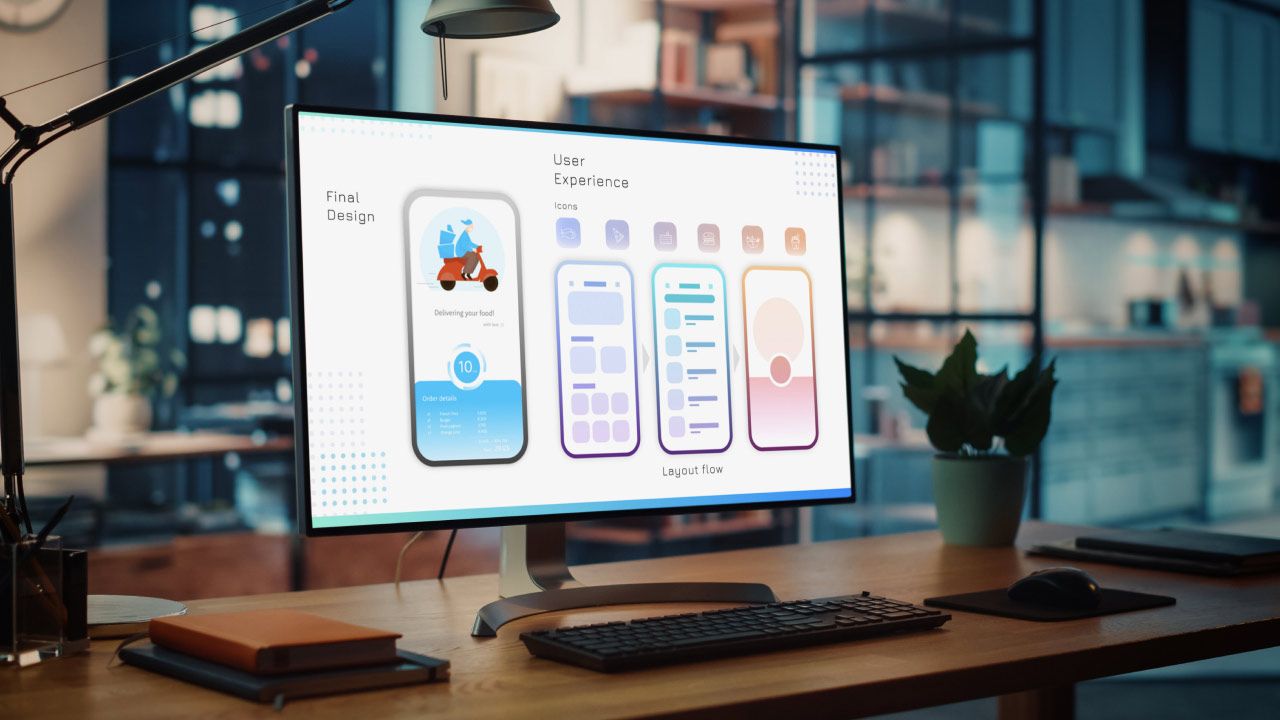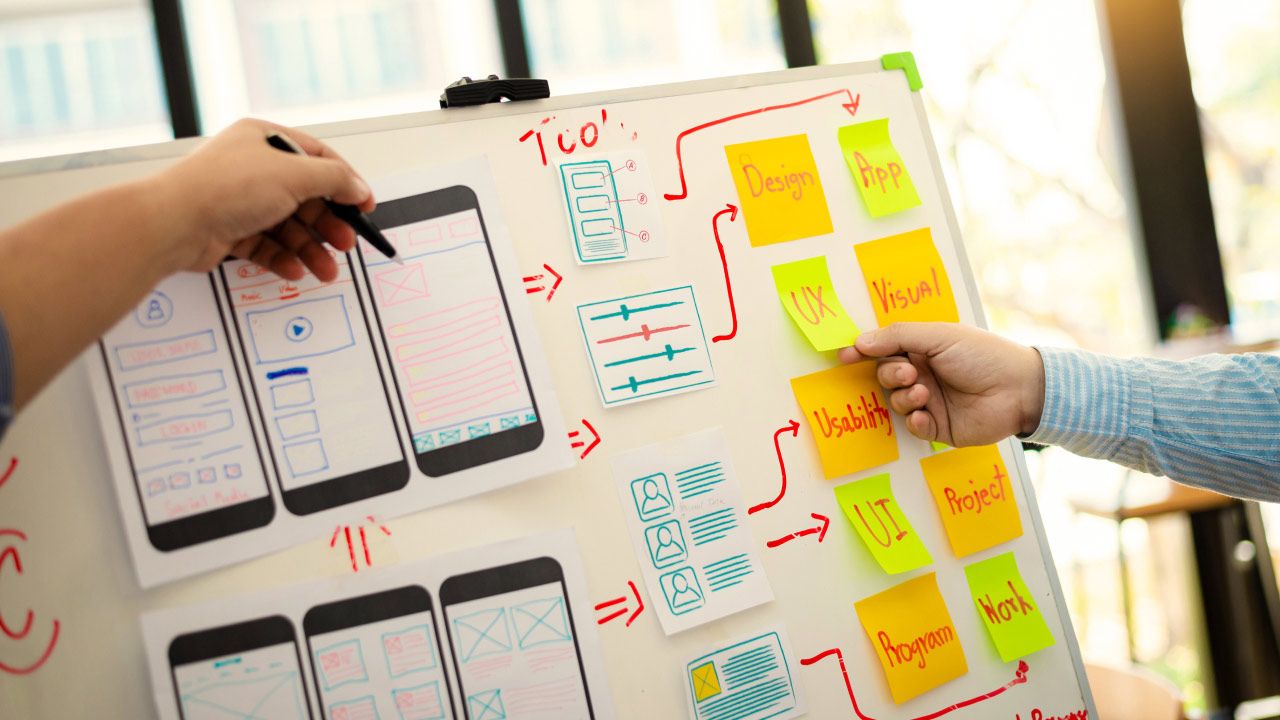What Is UX Design And What Do UX Designers Do? A Guide to User Experience Design
By Marco Franzoni • May 5, 2024

Introduction: Understanding UX Design
What is UX Design?
UX design, or User Experience design, is the art and science of shaping a product or service that offers a seamless and satisfying experience to its users. By focusing on the entirety of the user's journey, UX designers aim to create products that are not only usable but also delightful to interact with. This process involves a deep dive into user research, extensive planning of user flows, and meticulous attention to every interaction point within a product.
The Importance of UX in Today's Digital World
In today's digital age, where countless apps, websites, and digital services vie for attention, UX design has never been more crucial. A well-designed user interface, informed by comprehensive user experience research, can significantly enhance customer retention and satisfaction. By prioritizing the user's experience, companies not only foster brand loyalty but also gain a competitive advantage in the market. UX design isn't just about making things look good—it's about making technology easy, enjoyable, and accessible for all users, ultimately defining the success of modern digital products.
This introduction serves as a gateway into the world of UX design, underscoring its pivotal role in today's tech-driven landscape. Through understanding what UX design encompasses and why it's essential, readers can appreciate its impact on every digital interaction they encounter.
Exploring the Basics of UX Design
What is a UX Designer?
A UX designer, or User Experience designer, is a professional who focuses on enhancing the usability, accessibility, and pleasure provided in the interaction between the user and the product. They are pivotal in shaping products that are not only functional but also enjoyable and intuitive. UX designers conduct extensive user research, develop user personas, and design wireframes and prototypes to test and refine interactions. Their goal is to ensure that every digital solution is tailored to meet the needs and expectations of real users, facilitating a smooth and engaging user experience.
UX/UX: Understanding the Terminology
Often, people come across the term "UX/UX" and wonder about its meaning. Essentially, this is a typographical error that should read "UX/UI", referring to User Experience and User Interface design—two disciplines that work hand-in-hand to create compelling digital experiences. While UX design focuses on the overall feel of the experience, UI design deals with the specific assets users interact with. Together, they ensure that the user's journey through an app, website, or software is not just visually pleasing but also functionally efficient.
This section has explored the core functions of a UX designer and clarified the common confusion surrounding UX-related terminology. By understanding these basics, readers can better appreciate the intricate work and strategic thinking involved in crafting successful user-centered designs.

The UX Design Process Explained
The UX Design Process in 5 Steps
The UX design process is a structured approach to creating products that deliver meaningful and relevant experiences to users. It involves five critical steps:
- User Research: Extensive user research is conducted to understand the needs, motivations, and behavior of the target audience.
- Design & Prototyping: Based on the insights gained, UX designers develop wireframes and prototypes to visualize the user interactions.
- Usability Testing: These prototypes are then tested with real users to gather feedback and identify pain points in the user experience.
- Iteration: Using the feedback, the design is refined and iterated upon to enhance its usability and appeal.
- Implementation & Evaluation: The final design is implemented, and its impact on user experience is continuously evaluated.
Start with a Deep Understanding of Users and Their Intent
A successful UX design process begins with a deep understanding of the users and their intent. This involves conducting detailed market research, focus groups, and user interviews to capture the comprehensive user needs and expectations. It's about empathizing with the end user and understanding their journey from start to finish.
Develop a Plan for How Users Should Experience Your Product
Developing a plan for how users should experience your product involves mapping out the entire user journey, from the first interaction to the last. This includes defining the user flows, which outline the path a user follows within the product, ensuring that each step is intuitive and leads naturally to the next. UX designers work to create a seamless flow that enhances the overall usability and ensures that the user's interaction with the product is both efficient and enjoyable.
This section of the post explores the systematic approach to UX design, emphasizing the importance of understanding user needs and carefully planning the user experience. By following these guidelines, UX designers can create products that not only meet but exceed user expectations, ultimately leading to higher customer satisfaction and retention.
Hard Skills and Tools for UX Designers
Hard Skills UX Designers Need
To excel in the field of UX design, professionals need a robust set of hard skills. These include proficiency in interaction design, understanding of user interface design principles, and a solid grasp of usability testing methodologies. Additionally, UX designers often require some coding skills, particularly in HTML, CSS, and JavaScript, to effectively communicate their designs to developers and occasionally make tweaks themselves. Mastery of graphic design principles, along with an ability to conduct extensive user research, is also crucial for creating designs that are not only functional but also visually appealing.
What Tools Do UX Designers Use?
UX designers rely on a wide array of tools to bring their designs to life. Industry-standard tools such as Adobe XD, Sketch, and Figma facilitate wireframing, prototyping, and collaboration among design teams. For user research, tools like UserTesting and Lookback.io are essential for gathering real-time feedback through usability tests. Information architecture and user flow can be mapped out using tools like Axure and Balsamiq. Additionally, newer tools like InVision Studio and Marvel offer powerful options for creating interactive elements and simulating user interactions to refine the user experience before development begins.
This section has delved into the essential skills and tools that form the backbone of effective UX design. By combining these skills with the right tools, UX designers are equipped to tackle complex design challenges and create products that meet the needs and expectations of end users.

The Role of UX Designers in Different Contexts
Company Size Determines the Scope of What a UX Designer Does
The role of a UX designer can vary significantly based on the size of the company they work for. In a startup, a UX designer might wear multiple hats, handling everything from initial user research and persona development to the final UI design and user testing. This requires a broad skill set and flexibility to adapt to various tasks that may go beyond traditional UX roles.
Conversely, in larger corporations, a UX designer's role is often more specialized. They might focus exclusively on specific aspects of the design process, such as user research, interaction design, or usability testing. These designers typically work as part of a larger team where tasks are more segmented, allowing for deeper focus on each phase of the design process. This specialization can lead to producing multiple versions of a design, refining each based on detailed user feedback and iterative testing.
Types of UX Designer Jobs
The UX design industry offers a range of job titles and roles, each with distinct responsibilities and focus areas. Some of the common types of UX designer jobs include:
- UX Researcher: Specializes in understanding user behaviors, needs, and motivations through observation techniques, task analysis, and other feedback methodologies.
- Interaction Designer: Focuses on creating engaging interfaces with well-thought-out behaviors. They ensure that the product logically flows from one step to the next.
- Visual/UI Designer: Concentrates on the aesthetics of a product and its related materials by strategically implementing images, colors, fonts, and other elements.
- Information Architect: Works to create a structured layout of information that allows users to find information and complete tasks easily.
- UX Strategist: Combines UX design and business planning by integrating the brand's business strategies with innovative digital solutions.
This section highlights how the scope and responsibilities of UX designers can differ based on the company size and the specific role they play within the industry. Understanding these variations is crucial for anyone looking to build a career in UX design, ensuring they can find a role that best fits their skills and career aspirations.
UX vs. UI: Clarifying the Differences
The Difference Between UX and UI Design
UX (User Experience) design and UI (User Interface) design are two facets of the web and app design process, often used interchangeably but distinct in their focus. UX design encompasses the overall experience a user has with a product, including how easy or pleasing it is to use, and how well it enables users to achieve their goals. This involves designing the entire user journey, from initial interaction to final outcome, ensuring it meets the needs of the user.
UI design, on the other hand, focuses specifically on the look and layout of the product. It involves choosing color schemes, button shapes, the width of lines, typography, and other visual elements. UI designers create the touchpoints that users interact with, ensuring that the interface is intuitive and aesthetically pleasing.
Is UX Design the Same as UI Design?
While UX design and UI design are closely related, they are not the same. UX design is a process that considers the comprehensive user experience, which includes UI as one of many elements. The goal of UX design is to create a product that is not only efficient and easy to use but also resolves pain points and enhances the user's interaction with the company or brand.
UI design is a component of that process, with a narrower focus on the visual aspects of the user's interface. It's about how the product looks and feels; UX is about the overall effectiveness and experience. Successful products depend on both disciplines working in concert; great visual design cannot save an interface that is cumbersome to navigate, and a well-designed user flow can be undermined by poor visual elements.
This section delineates the essential roles both UX and UI design play in creating compelling digital products, clarifying their unique focuses and how they interact to shape user experiences.

Practical Aspects of Being a UX Designer
What are a UX Designer's Tasks?
A UX designer's tasks are multifaceted and integral to the development of any digital product. At the core, these tasks include extensive user research to understand the needs and behaviors of the target audience. This research often involves conducting interviews, focus groups, and usability tests to gather real user feedback. From these insights, UX designers develop user personas and user flows, which help in decsigning interfaces that meet precise user needs.
UX designers are also heavily involved in the iterative design process, where they create wireframes, prototypes, and high-fidelity designs. These are continually refined based on user testing to ensure the product is both intuitive and effective. Other crucial tasks include collaborating with UI designers to ensure that the visual design supports the overall user experience and working with developers to implement the design with the right functionality.
What Kinds of Projects Do UX Designers Work On?
UX designers work on a diverse range of projects across various platforms, including web and mobile apps, desktop software, and even physical products that require digital interaction. Their projects can vary from developing a new feature for an existing app to designing the entire user experience for a new product. Each project typically follows the UX design process, from research and design to testing and implementation.
In addition to product design, UX designers may also work on improving the usability of existing products through redesigns based on user feedback and new market research. This often leads to multiple versions of a product being developed over time, each iteration improving on the last based on continuous user testing and usability testing.
This section highlights the dynamic and essential roles of UX designers within the development process, showcasing the broad spectrum of tasks they perform and the diverse types of projects they influence.
The Importance of User Research and Testing
User Research
User research is a cornerstone of effective UX design, providing the insights needed to craft experiences that genuinely resonate with users. This phase involves engaging with real users through various methodologies such as interviews, surveys, and observational studies. The goal is to gather as much relevant information as possible about the users' needs, behaviors, motivations, and pain points. This extensive user research is vital for creating user personas and user flows that accurately reflect the end user's interaction with the product. It ensures that every design decision is informed by data and real-world application.
Not Testing Before Iterating on Product Design
Skipping the testing phase before iterating on product design is a common pitfall that can lead to suboptimal user experiences. Conducting user tests and usability tests is crucial for validating design concepts and identifying any usability issues that might not be apparent during the design phase. These tests involve real users interacting with prototypes or beta versions of a product, providing feedback that is integral to the iterative process. Ignoring this step can result in a product that looks good on paper but fails in practical use, ultimately affecting customer retention and satisfaction.
Testing is not just a one-time task but a continuous part of the UX design process that helps refine the product to better meet user needs and exceed their expectations. By incorporating regular feedback loops through user testing and usability testing, UX designers can ensure that the product evolves in a direction that enhances user satisfaction and drives business success.
This section emphasizes the critical role that thorough user research and continuous testing play in the UX design process, highlighting how they contribute to creating products that are not only usable but also deeply aligned with the needs of the target audience.
Career Path in UX Design
How to Become a User Experience Designer
Embarking on a career as a user experience designer involves cultivating a diverse set of essential skills ranging from user research and interaction design to visual communication and prototyping. Prospective UX designers often begin by pursuing relevant educational paths, such as degrees in design, computer science, or human-computer interaction. Building a robust design portfolio showcasing a variety of projects is crucial as it demonstrates your ability to apply UX principles in real-world scenarios.
Additionally, gaining practical experience through internships or entry-level positions is invaluable. Joining a UX team and participating in the entire design process from ideation to deployment can provide hands-on experience that is critical for professional growth. Engaging with the UX design community and continuing to learn about new tools and trends are also important steps in becoming a successful UX designer.
Is UX Design a Good Career?
UX design is widely regarded as a rewarding and in-demand career. As businesses increasingly recognize the importance of providing excellent user experiences to retain customers, the demand for skilled UX designers continues to grow. This career not only offers the potential for creative fulfillment but also stability and a competitive salary. UX designers have the opportunity to impact a wide range of industries, making it an appealing choice for those looking to make a significant difference through their work.
Do User Experience Designers Need to Code?
While not all UX designers need coding skills, having a basic understanding of HTML, CSS, and JavaScript can be highly beneficial. Coding skills can help designers better communicate with developers and sometimes allow them to make minor adjustments to designs themselves. However, the necessity of coding skills often depends on the specific role and the team structure. Some positions may require more technical abilities, while others focus more on the conceptual and research aspects of UX design.
This section outlines the pathways into the UX design profession, discusses the career's benefits, and addresses the role of coding skills in a UX designer's toolkit. It highlights the dynamic nature of the field and the various opportunities it presents for aspiring designers.

Conclusion: The Future of UX Design
Why is UX Design Important for Product Teams?
UX design is crucial for product teams because it directly influences user satisfaction and engagement. A well-designed user experience ensures that products are not only functional but also enjoyable to use, which is essential for customer retention and loyalty. By focusing on the user's needs and behaviors, UX design helps in building products that are intuitive and meet real-world demands. This alignment with user expectations increases the likelihood of success in a competitive market and enhances the overall brand reputation.
The Competitive Advantage of Design-Driven Companies
Companies that prioritize UX design gain a significant competitive advantage. Design-driven companies are often more successful because they commit to delivering superior experiences that resonate with their users, leading to higher satisfaction rates and brand loyalty. This focus on design tends to foster innovation and drives companies to continually improve their products and services, ensuring they stay relevant and desirable in a rapidly changing marketplace.
Design-driven strategies are increasingly becoming a key differentiator in many industries, with successful UX designers at the forefront of this shift. As technology evolves, the role of UX design will only grow, making it an indispensable part of creating future technologies that are not only powerful but also user-centric.